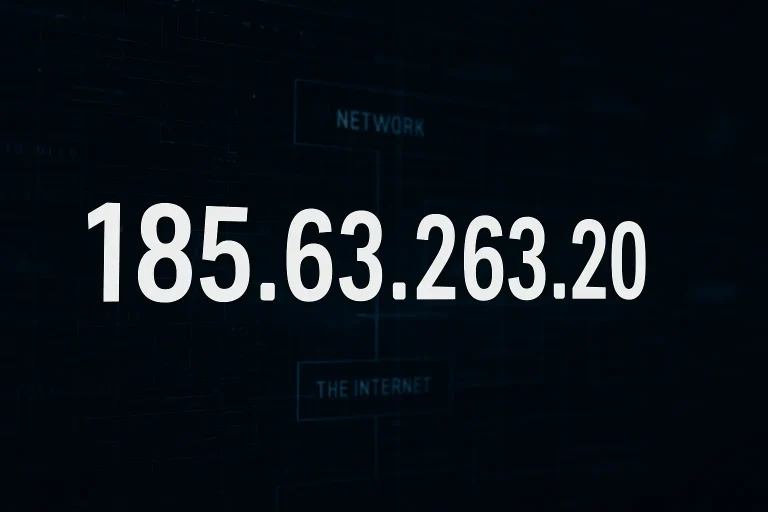
Have you ever seen the IP address 185.63.263.20 appear in your server logs, firewall alerts, or network monitoring tools and wondered what it meant? At first glance, it looks like a typical IPv4 address. However, upon closer inspection, you’ll notice that it is technically invalid, because the third segment exceeds the maximum allowed value of 255.
While this might seem alarming, its appearance does not automatically indicate that your system has been compromised. Instead, it usually signals misconfigurations, automated scanning activity, spoofed traffic, or logging anomalies. Understanding why this IP appears, what risks it might represent, and how to respond is critical for network security. In this comprehensive guide, we’ll break down the technical details, explore potential threats, provide actionable investigation steps, and offer practical tips to ensure your systems remain secure and resilient against such unusual activity.
What Is 185.63.263.20?
An IPv4 address consists of four numbers (called octets), each ranging from 0 to 255, separated by periods. These numbers uniquely identify devices on a network.
185.63.263.20 is invalid because the third octet, 263, exceeds the maximum of 255. This means:
-
No real device can legitimately use this IP.
-
It cannot be routed on the internet.
-
Its appearance in logs is often due to typos, spoofing, or automated traffic generation.
Despite being invalid, the address can show up in server logs, web analytics, or monitoring tools, making it important to understand why it appears.
Why It Appears in Your Logs
There are several common reasons this IP might appear:
-
Typographical Errors – Someone may have misconfigured a script, firewall rule, or server setting, entering “263” instead of a valid octet.
-
Spoofed or Fake Traffic – Malicious actors sometimes use invalid IP addresses to mask their true location or confuse logging systems.
-
Automated Scanning – Bots often generate random or invalid IPs when probing networks for vulnerabilities.
-
Search Engine Visibility – Discussions and articles referencing this IP can make it appear frequently in search results or reports.
Although seeing 185.63.263.20 in your logs does not directly indicate a cyberattack, it is a signal to investigate potential network anomalies.
Potential Risks Associated with This IP
While the IP itself is not dangerous, its presence can be a sign of possible issues:
-
Reconnaissance Activity – Repeated requests from unusual IPs may indicate someone is scanning your network for vulnerabilities.
-
Obfuscation and Spoofing – Attackers can use invalid IPs to hide their true source or confuse security tools.
-
Log Pollution – Invalid IPs may clutter your logs, making it harder to identify real threats.
Monitoring patterns around these IPs, such as repeated login attempts or access to sensitive endpoints, is essential to detect early warning signs of malicious activity.
How to Investigate and Respond
-
Analyze Server Logs – Look for timestamps, request types, frequency, and endpoints accessed by this IP.
-
Check Traffic Patterns – Identify any abnormal activity, such as repeated login failures or suspicious API requests.
-
Set Alerts – Configure monitoring tools to notify you of repeated or unusual IP appearances.
-
Block or Rate-Limit – Consider blocking repeated attempts from this IP or applying rate-limiting to reduce potential abuse.
-
Secure Your Systems – Ensure all services are updated, unused ports are closed, and sensitive endpoints are protected with strong authentication.
-
Educate Your Team – Make sure your IT and security teams can identify and investigate unusual IP addresses effectively.
These steps help you respond appropriately without overreacting to an IP that cannot exist on the internet.
Broader Lessons for Network Security
-
Always Monitor Unfamiliar IPs – Even invalid IPs may indicate probing or scanning.
-
Validate IP Addresses – Ensure your systems differentiate between valid and invalid addresses.
-
Layered Security Approach – Use firewalls, intrusion detection, rate-limiting, and monitoring.
-
Regular Log Analysis – Routine review helps detect anomalies before they escalate.
-
Maintain System Hygiene – Keep software updated, enforce strong passwords, enable MFA, and restrict unnecessary access.
Recognizing anomalies early helps protect your network from both minor irregularities and serious threats.
185.63.263.20 What It Means and How to Handle It
Conclusion
The appearance of 185.63.263.20 in your logs may initially raise concerns, but it is an invalid IPv4 address, as its third octet exceeds the allowable range. Its presence typically signals configuration errors, automated scanning activity, spoofed traffic, or logging anomalies rather than a direct attack. However, ignoring it completely could mean missing early indicators of network probing or suspicious behavior.
By reviewing logs, analyzing traffic, setting alerts, and applying basic security hygiene, you can respond effectively while maintaining a secure environment. Learning to identify unusual IPs like this one strengthens your network defense, ensures better visibility into potential threats, and prevents minor anomalies from escalating into serious issues. Staying vigilant, proactive, and informed is the best strategy for managing not only invalid IP addresses but all forms of unexpected activity on your network.
FAQs
-
Why does 185.63.263.20 appear in my server logs?
It often appears due to misconfigured scripts, typos, or spoofed traffic generated by automated bots. -
Is 185.63.263.20 a threat to my system?
Not directly. The IP itself is invalid, but repeated requests may indicate reconnaissance or scanning activity. -
Should I block this IP?
Yes, especially if it appears repeatedly. Blocking or rate-limiting reduces potential abuse and simplifies log monitoring. -
How can I tell if it is part of a larger attack?
Look for repeated failed logins, unusual endpoints accessed, or patterns associated with other suspicious IPs. -
What steps should I take for unusual IPs in general?
Regularly review logs, secure endpoints, enable monitoring and alerts, keep systems patched, and enforce strong authentication.